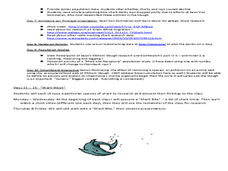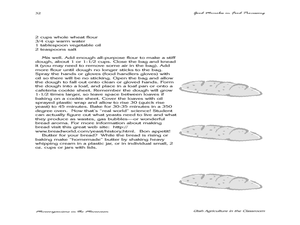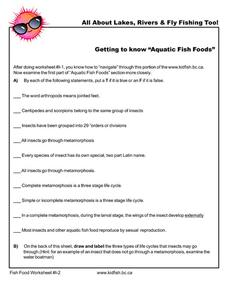Curated OER
Survival of the Fastest: Predator and Prey in the African Savannah
Students explore the predator-prey relationship using an interactive game. In this biology lesson, students compare their physical attributes. They explain how predators develop to make it stronger and efficient as hunters. Each group...
Curated OER
The Greening of Mars: The Changes Necessary to Sustain Life on Mars
Fifth graders discuss the currents conditions on the planet of Mars. In groups, they work together to develop a mechanism that allows for a balanced ecosystem to survive on the planet. After presenting their ideas to the class, they...
Curated OER
Create a Creature
Students design, build, draw, or bake a creature of their choice and present to the class. They write a paper including the creature's habitat, method of getting energy, their creature as a producer or consumer, predator or prey species...
Curated OER
Mosquito Life Cycles
Learners gather mosquito eggs to record the mosquito life cycle using drawings, descriptions, and any other appropriate means. In small groups, they analyze and describe the process of complete metamorphosis. They classify mosquitoes...
Curated OER
Digestive System Journey
Students explore what happens to the food they eat as it passes through their body. They demonstrate their understanding of the digestive system functions by choosing to create a poster, build a model, produce a multimedia presentation,...
Curated OER
Ecosystem Interdependence
Students outline a scenario demonstrating ecosystem interdependence. They explain the effects of this change according to the food web. They give a positive example such as increased rain and have the students call out answers to your...
Curated OER
Fruit or Vegetable?
Watermelon is a vegetable? A tomato is a fruit? Believe it or not, this debate is decades old. Groups examine rulings by the US Supreme Court, the USDA, and state statutes before developing their own criteria to use when labeling the...
Curated OER
What Happens When You Eat?
Students explore digestion. In this Human Body lesson plan, students participate in six different activities pertaining to the Digestive System. Students gain understanding of digestion through experimentation and investigation. Students...
Curated OER
Soak it up
Students complete a hands on activity using hard boiled eggs, food coloring, tape, cups, water, and a knife to show how permeability affects animals. In this permeability lesson plan, students complete this activity and learn how...
Curated OER
Electromagnets- 6 Mini Investigations
Third graders discover the properties of electromagnets through experiments. In this electromagnet properties lesson, 3rd graders complete six tasks with an elctromagnet. Students recognize that the wires will heat up when connected to...
Curated OER
Go Fish! Exploring The Tragedy of the Commons
Learners discover what happens when people take advantage of shared resources. In this ecology instructional activity, students explore "The Tragedy of the Commons" by playing a role playing simulation game in small groups. Learners soon...
Curated OER
The Open Ocean, What is it and How Does it Change?
Students investigate the ocean environment. In this ocean lesson, students discover the physical properties of the ocean. Over two days, students work in small groups investigating ocean maps and creating water currents.
Curated OER
Microorganism Multiplication
Sixth graders conduct experiments with yeast to study characteristics of microorganisms. They, working is small groups, change the variables in the experiments and note the results which they later discuss as a class.
Curated OER
Chemical Reactions - Borax & Glue, Cream
Fifth graders, in groups, complete two activities in which various substances are combined, resulting in a very different substances. They discuss reactants and products and chemical reactions.
Curated OER
In My Own Backyard
Students explore the soil and vegetation found in their home and/or school environment and map a familiar area. Each group is assigned a section of the schoolyard. They draw maps of their assigned places and gather soil and vegetation...
Curated OER
Mapping Animal Behavior
Young scholars discuss the value of sampling in science. They, in groups, map cricket movement in response to various stimuli and graph their results.
Curated OER
Renewable Energy Sources
Place learners into groups to research and present different renewable energy sources. As individuals listen to the class presentations, they take notes and then write a persuasive article defending the form of energy that they feel...
Curated OER
Three Easy Steps To a Fungus Feast
In this science worksheet, students discover the relationship between the leaf cutter ant and fungus. Students perform an investigation, following specific directions. Note: This investigation requires an ant colony of 700,000 ants, plus...
Curated OER
Yo! Gert-making yogurt
Young scientists or chefs culture yeast to produce yogurt. The materials and a general description of how make yogurt are provided, but there is very little detail otherwise. You could use this as an activity when your biology class is...
Curated OER
Life Science- Useful Waste
Fourth graders explore the topic of waste and recycling. In this useful waste instructional activity, 4th graders classify objects and sort them into most usable and least usable categories. Students complete an activity sheet and have a...
Curated OER
The Science of Glaciers
Students identify the contents of a glacier like those found in Patagonia. They construct a mini glacier model in class. Students compare and contrast the classroom model with Patagonian glaciers. They label specific parts of the...
Curated OER
Good Microbes in Food Processing
Students participate in a bread making experiment to understand the good microbes in bread. In this bread making lesson, students prepare bread in a bag with varied recipes and note results.
Curated OER
Getting to Know "Aquatic Fish Foods"
In this fish worksheet, students access a website to learn more about the common insects eaten by fish. Then students draw and label three types of insect life cycles. This worksheet has 10 true or false questions and 3 drawings.
Curated OER
Food Chemistry: The Chemistry of Sweeteners
Students investigate the properties of sweeteners. For this chemical property lesson, students examine the unique properties of sweeteners by performing several experiments. They will analyze the data to form a conclusion about the...

























